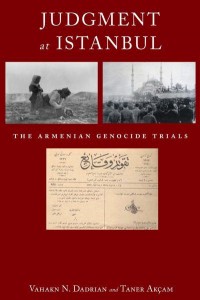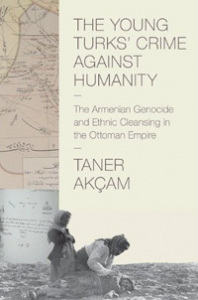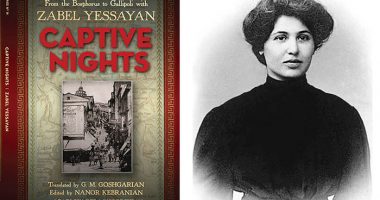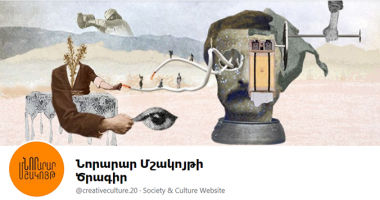

Two Reviews by Amb. (ret.) John M. Evans
The Young Turks’ Crime Against Humanity:The Armenian Genocide and Ethnic Cleansing in the Ottoman Empire By Taner Akçam, ISBN-13-978-0691153339,Princeton University Press, 2012, 483 pp. $39.50, Kindle edition: ASIN:B007BP3BIU, $21.73.
Judgment at Istanbul: The Armenian Genocide Trials By Vahakn N. Dadrian and Taner Akçam, ISBN-13-978-0857452511, Zoryan Institute (Berghahn Books), 2011, 363 pp., $110.00
These two books are the latest, and perhaps most conclusive, of the many I have read about the 1915 Armenian Genocide. Dr. Taner Akçam’s The Young Turks’ Crime Against Humanity: The Armenian Genocide and Ethnic Cleansing in the Ottoman Empire (Princeton University Press, 2012) constitutes a major breakthrough in our understanding of the social engineering that led to the near destruction of the Armenians of Anatolia, and of the dual-track mechanism for organizing it that the Young Turks employed. Judgment at Istanbul: The Armenian Genocide Trials (Zoryan Institute; 2011) co-authored by Akçam and veteran Armenian historian Vahakn Dadrian, gives the English-speaking world, for the first time, the full story of the courts-martial constituted by the Ottoman Government in 1919 to hold to account the perpetrators of the deportations and massacres (seven of the most important of whom had already escaped to safety on a German warship).


Both volumes are a must for serious scholars of the Armenian Genocide, but The Young Turks’ Crime Against Humanity is the better value for most readers (Judgment at Istanbul, published first in Turkish in 2008, and now in English from Berghahn Books, lists at $110), although university libraries will want to have both.
Dr. Akçam, a Turkish historian now at Clark, was the first scholar of Turkish origin to recognize the Armenian Genocide; he has made huge contributions to understanding it in his 2004 From Empire to Republic: Turkish Nationalism & the Armenian Genocide and A Shameful Act: The Armenian Genocide and the Question of Turkish Responsibility (2006) and in innumerable articles and lectures.
A close friend of the Turkish Armenian journalist Hrant Dink, who was assassinated on an Istanbul street in January, 2007, Akçam has himself been the target of death threats, yet he has continued to mine the Ottoman archives, which he is able to read in the pre-reform script, with jaw-dropping results.
One of his recurring themes is that the Ottoman archives, far from painting a picture at odds with that which is already familiar to scholars of American, German and Austrian documentation, actually confirm the basic facts of the 1915 atrocities. But what Akçam has managed to do, this time by scouring the archives of the Ministry of the Interior (presided over at the time by Talat Pasha), is to bring to light the steady, mechanical and precise nature of the Young Turks’ obsession with reducing the Armenian population of Anatolia to 5 to 10 per cent of the population in all localities — a goal that required both forced deportations, carried out with an outward show of legality, and massacres, secretly ordered through special channels and carried out in large part by the Special Organization () and bands of Kurdish marauders.
In a way, Akçam’s account is oddly reassuring, as it gets to a basic and banal, if also horrifying, truth: the Turks did not so much loathe the Armenians as view them as competitors in the impending challenge of building a new state, inspired by extreme Turkish nationalism, on the ruins of the defunct Ottoman Empire.
This is not to understate the crimes committed, which included rape, forced assimilation and murder, as well as wholesale expropriations of land and property: genocide, in short. But as atrocious as the Young Turks’ behavior was, it is somehow more comprehensible in terms of the dark logic of Turkish ultra-nationalism, and not just as a result of free-floating ethnic or religious hatred. Still, as Akçam shows, the other Christian and non-Turkish populations — Greeks, Assyrians and Kurds — similarly did not fit into this state-building project, but it was the Armenians who were most savagely targeted for annihilation. They clearly were not removed for “wartime necessity,” as Akçam demonstrates. In particular, it emerges that the Armenian Reform Agreement (Yeniköy Accord) of 1914, forced on the Sultan by the Allies, notably Russia, was viewed by the Young Turks as a major threat — and ultimately did a terrible disservice to the Armenians.


Akçam is very careful not to let his elucidation of the causes of the atrocities be taken as a justification for the Genocide — he does not “blame the victim,” — but I expect his work will draw critics to the extent it fails to confirm long-held assumptions, assertions and denials.
Meanwhile, the earlier (and less accessible) book, Judgment at Istanbul, painstakingly mines the pages of the Takvim-i-Vekâyi (the official organ of the Ottoman Parliament), court records and the Turkish press to demonstrate the sheer scale and broad involvement of Turkish officialdom and society in carrying out the deportations and worse.
Both volumes, to be fair, record also a few exculpatory episodes of Turkish officials who would not go along with the Committee of Union and Progress’s murderous plans and paid dearly for their refusal to obey orders. When the Ottoman courts-martial targeted Mustafa Kemal (the future Atatürk), not for genocide, but for mutiny, he ultimately responded by tearing down the 800-year-old dynasty at the head of the nationalist movement that launched the War of Independence and created the Republic of Turkey. While Ataturk was not directly involved in the 1915 genocide (the term “a shameful act” is his), many of his confrères in building the new Turkish state were, and the pattern of official denial was set early on. With less than two years to go until the centenary, much will yet be written, but I doubt as much light will be shed as by these two valuable volumes.
All students of the Armenian Genocide owe Taner Akçam and Vahakn Dadrian a great debt for their persistent and systematic scholarship over the years against very heavy headwinds, including the outright hostility of certain states.
John M. Evans, a career Foreign Service Officer who served as the U.S. Ambassador to Armenia from 2004 to 2006, stirred controversy in February 2005 by publicly dissenting from the policy of the Bush Administration on the 90-year-old issue of the Armenian Genocide. A native of Williamsburg, VA, educated at Yale and Columbia, Evans served in Tehran, Prague, Moscow, Brussels (NATO), the Organization for Security and Cooperation in Europe, St. Petersburg and Washington, reaching the rank of Minister-Counselor. He lives in Washington, DC.
Source: American Diplomacy










